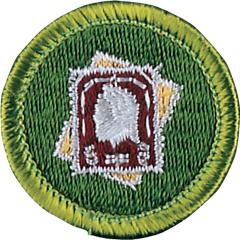Stamp Collecting Merit Badge

Overview
The world’s most popular hobby, stamp collecting is enjoyed by millions throughout the world. Through this hobby. you can experience history: postage stamps are like tiny windows that introduce the people of the world to the country’s leaders, customs, history, products, and environment.
Requirements
- (1) Do the following:
- (a) Discuss how you can better understand people, places, institutions, history, and geography as a result of collecting stamps.
- (b) Briefly describe some aspects of the history, growth, and development of the United States postal system. Tell how it is different from postal systems in other countries.
- (2) Define topical stamp collecting. Name and describe three other types of stamp collections.
- (3) Show at least ONE example of each of the following:
- (a) Perforated and imperforate stamps
- (b) Mint and used stamps
- (c) Sheet-booklet and coil stamps
- (d) Numbers on plate block, booklet, coil, or marginal markings
- (e) Overprint and surcharge
- (f) Metered mail
- (g) Definitive, commemorative, semipostal, and airmail stamps
- (h) Cancellation and postmark
- (i) First day cover
- (j) Postal stationery (aerogramme, stamped envelope, and postal card).
- (4) Do the following:
- (a) Demonstrate the use of ONE standard catalog for several different stamp issues. Explain why catalog value can vary from the corresponding purchase price.
- (b) Explain the meaning of the term condition as used to describe a stamp. Show examples that illustrate the different factors that affect a stamp’s value.
- (5) Demonstrate the use of at least THREE of the following stamp collector’s tool:
- (a) Stamp tongs
- (b) Water and Tray
- (c) Magnifiers
- (d) Hinges and stamp mounts
- (e) Perforation gauge
- (f) Glassine envelopes and cover sleeves
- (g) Watermark fluid.
- (6) Do the following:
- (a) Show a stamp album and how to mount stamps with or without hinges. Show at least ONE page that displays several stamps.
- (b) Discuss at least THREE ways you can help to preserve stamps, covers, and albums in first-class condition.
- (7) Do TWO of the following:
- (a) Design a stamp, cancellation, or cachet.
- (b) Visit a post office, stamp club, or stamp show with an experienced collector. Explain what you saw and learned.
- (c) Write a review of an interesting article from a stamp newspaper, magazine, book or Web site (with your parent or guardian’s permission).
- (d) Research and report on a famous stamp-related personality or the history behind a particular stamp.
- (e) Describe the steps taken to produce a stamp. include the methods of printing, types of paper, perforation styles, and how they are gummed.
- (f) Prepare a two- to three-page display involving stamps. Using ingenuity, as well as clippings, drawings, etc., tell a story about the stamps , and how they relate to history, geography, or a favorite topic of yours.
- (8) Mount and show, in a purchased or homemade album, ONE of the following:
- (a) A collection of 250 or more different stamps from at least 15 countries
- (b) A collection of a stamp from each of 50 different countries, mounted on maps to show the location of each
- (c) A collection of 100 or more different stamps from either one country or a group of closely related countries
- (d) A collection of 75 or more different stamps on a single topic. (Some interesting topics are Scouting, birds, insects, the Olympics, sports, flowers, animals, ships, holidays, trains, famous people, space, and medicine). Stamps may be from different countries.
- (e) A collection of postal items discovered in your mail by monitoring it over a period of 30 days. Include at least five different types listed in requirement 3.
Resources
- Stamp Collecting merit badge page
- Stamp Collecting merit badge PDF (local copy)
- Stamp Collecting merit badge pamphlet
Note: This is an unofficial archive of Scouts BSA Merit Badges that was automatically extracted from the Scouting America website and may contain errors.